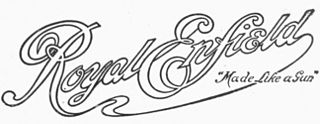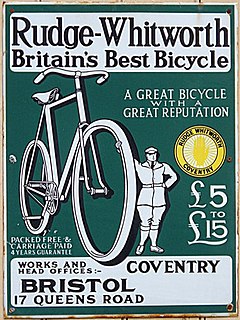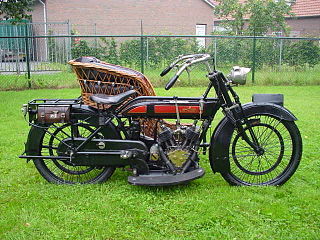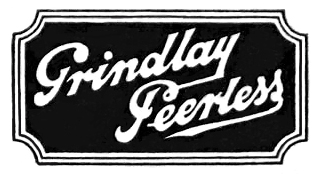
Velocette is a line of motorcycles made by Veloce Ltd, in Hall Green, Birmingham, England. One of several motorcycle manufacturers in Birmingham, Velocette was a small, family-owned firm, selling almost as many hand-built motorcycles during its lifetime, as the mass-produced machines of the giant BSA and Norton concerns. Renowned for the quality of its products, the company was "always in the picture" in international motorcycle racing, from the mid-1920s through the 1950s, culminating in two World Championship titles and its legendary and still-unbeaten 24 hours at over 100 mph (161 km/h) record. Veloce, while small, was a great technical innovator and many of its patented designs are commonplace on motorcycles today, including the positive-stop foot shift and swinging arm rear suspension with hydraulic dampers. The business suffered a gradual commercial decline during the late 1960s, eventually closing in February 1971.

A. J. Stevens & Co. Ltd was a British automobile and motorcycle manufacturer in operation from 1909 to 1931. The company was founded by Joe Stevens in Wolverhampton, England. After the firm was sold, the name continued to be used by Matchless, Associated Motorcycles and Norton-Villiers on four-stroke motorcycles till 1969, and since the name's resale in 1974, on lightweight, two-stroke scramblers and today on small-capacity roadsters and cruisers. The company held 117 motorcycle world records.

Royal Enfield was a brand name under which The Enfield Cycle Company Limited of Redditch, Worcestershire sold motorcycles, bicycles, lawnmowers and stationary engines which they had manufactured. Enfield Cycle Company also used the brand name "Enfield" without the "Royal".
Excelsior, based in Coventry, was a British bicycle, motorcycle and car maker. They were Britain’s first motorcycle manufacturer, starting production of their own ‘motor-bicycle’ in 1896. Initially they had premises at Lower Ford Street, Coventry, and 287-295 Stoney Stanton Road, Hillfields, Coventry, Warwickshire before moving to Kings Road, Tyseley, Birmingham in 1921.

Phelon & Moore manufactured motorcycles in Cleckheaton, Yorkshire, England from 1904 to 1967 particularly those under the Panther marque. They became identified with one particular design of motorcycle which had a large sloping 40-degree single-cylinder engine as a stressed member of the frame. This design spanned the entire history of the company, starting with a 500 cc model and ending with a 645 cc model.

Matchless is one of the oldest marques of British motorcycles, manufactured in Plumstead, London, between 1899 and 1966. A wide range of models were produced under the Matchless name, ranging from small two-strokes to 750 cc four-stroke twins. Matchless had a long history of racing success; a Matchless ridden by Charlie Collier won the first single-cylinder race in the first Isle of Man TT in 1907.

A motorcycle engine is an engine that powers a motorcycle. Motorcycle engines are typically two-stroke or four-stroke internal combustion engines, but other engine types, such as Wankels and electric motors, have been used.

The BSA Gold Star is a motorcycle made by BSA from 1938 to 1963. They were 350 cc and 500 cc single-cylinder four-stroke production motorcycles known for being among the fastest bikes of the 1950s. Being hand built and with many optional performance modifications available, each motorcycle came from the factory with documented dynamometer test results, allowing the new owner to see the horsepower (bhp) produced.

Rudge Whitworth Cycles was a British bicycle, bicycle saddle, motorcycle and sports car wheel manufacturer that resulted from the merger of two bicycle manufacturers in 1894, Whitworth Cycle Co. of Birmingham, founded by Charles Henry Pugh and his two sons Charles Vernon and John, and Rudge Cycle Co. of Coventry.
OK-Supreme was a British motorcycle manufacturer from 1899 to 1939 located in Birmingham. Grass-track racing versions of the machines continued to be available until 1946.

Levis motorcycles (1911–1940), manufactured by Butterfields Ltd. of Birmingham, England were for many years one of England's leading marques of two-stroke motorcycle. Levis built two-stroke machines from 1911, adding a line of four-strokes in 1928, which ran to 1941 when production ceased.
Rex, Rex Motorcycles, Rex-Acme, was a car and motorcycle company which began in Birmingham, England in 1900. Rex soon merged with a Coventry maker of bicycles and cars named Allard and then later in 1922 the company merged with Coventry's 'Acme' motorcycle company forming 'Rex Acme'. The company existed until 1933, and, in its heyday, was considered one of the greatest names in the British motorcycle industry.

Francis & Barnett Limited was an English motorcycle manufacturer founded in 1919 by Gordon Inglesby Francis and Arthur Barnett and based in Lower Ford Street, Coventry, England. Early motor cycles were affectionately known as ' Franny B'. Motorcycles were produced for enthusiasts and was reasonably affordable for citizens for use as general transport. The majority of the lighter motorcycles used Villiers and later Two-stroke engine and later Associated Motor Cycles AMC engines. During the 1930s the 250cc Cruiser model 250 cc (15 cu in) was developed with a faired engine that protected those riding from any oil or dirt – one of the first of its kind to do so. AMC took over Francis & Barnett Limited in 1947 combining this with the James motorcycle models in 1957. The combined company remained in business until 1966.
Blackburne was a trade name of Burney and Blackburne Limited a British manufacturer of motorcycles from 1913 to 1922 at Tongham near Farnham, Surrey. They were also a major supplier of engines to other motor cycle and light car makers and continued to make these until 1937. Burney and Blackburne also made small aircraft engines.
Greeves Motorcycles was a British motorcycle manufacturer founded by Bert Greeves which produced a range of road machines, and later competition mounts for observed trials, scrambles and road racing. The original company produced motorcycles from 1952, funded by a contract with the Ministry of Pensions for their Invacar, a three-wheeler for disabled drivers.

Tornax was a motorcycle manufacturer in Wuppertal, Germany.

Osborn Engineering Company was a British manufacturer of motorcycles, which sold its machines under the OEC brand name.

The Ruby Cycle Co Ltd. was a British motorcycle manufacturer based in Ancoats Manchester. Founded in 1909 the factory produced a range of motorcycles under the Royal Ruby brand until 1932.

BSA motorcycles were made by the Birmingham Small Arms Company Limited (BSA), which was a major British industrial combine, a group of businesses manufacturing military and sporting firearms; bicycles; motorcycles; cars; buses and bodies; steel; iron castings; hand, power, and machine tools; coal cleaning and handling plants; sintered metals; and hard chrome process.

Grindlay Peerless is a historic motorcycle manufacturer that operated out of Coventry, England, throughout the early 20th-century, specialising in racing machines including the record breaking 498cc Grindlay Peerless.




















